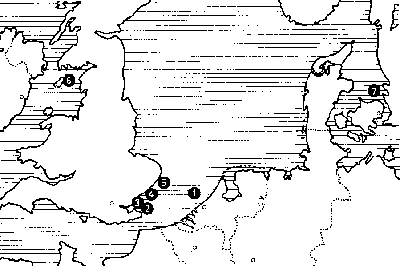Although there had been a Dutch "pirate", Radio Veronica, operating since 1960, this was the first of the UK "pirates" and they were to change completely the style and sound of British radio. Edward Pawley notes that:
'About 6dB of compression was used on long and medium wave transmitters from February 1961... in March 1964 the "pirate" stations started to operate...giving stronger signals in some coastal areas than the BBC stations. The degree of volume compression applied to MF transmissions of Home and Light programmes was increased to 12dB in February 1965 to improve their effective competitiveness.' *The word "pirate" implies illegality; in fact the ships were not breaking any laws as they were operating in international waters but they soon would be when new laws had been passed.
Radio Caroline was soon joined by other ships and the EBU Review in its 'International News' section started printing reports 'On the high seas'. In February 1965 there was this item: **
On the high seas
The two "pirate" stations set up on the artificial island anchored off Noordwijk (Netherlands) closed down permanently on 17 December 1964. They had been known as "TV Noordzee," a television station working in Channel 11, and "Radio Noordzee," a sound-broadcasting station working on 1400 kHz. As soon as an Act of the Netherlands Parliament declaring such activities illegal was given the Royal Assent, the Government in effect took direct action against the exploiting organisation, and the island was occupied by the police. Thus these two pirate stations enjoyed a relatively short life, the sound-broadcasting station having opened at the end of July 1964 and the television station in mid-August 1964.
Regarding the stations in the vicinity of the British Isles, "Radio City", which has very often changed frequency since it began operations in May 1964, has been working on 1034 kHz since mid-December 1964. It has had a second transmitter working on 1625 kHz (just outside the medium-wave broadcasting band) since mid-January 1965. The station "Radio Invicta", set up in a tower in the Thames Estuary, has announced itself as "Radio King" since the beginning of February 1965, which may perhaps indicate a change of ownership.
However, the most important information to be imparted in this matter is not technical, but juridical. On 21 January 1965, the Council of Europe adopted a convention in favour of prohibiting pirate broadcasting stations. The convention has already been signed by the Belgian, Danish, French, Greek, Luxembourg, Swedish and United Kingdom delegations. The signatory governments undertake not to permit, in their respective countries, collaboration with broadcasting stations installed in ships on the high seas. Collaboration in this context is defined as including the supply of equipment, provisions or means of transport and the supply of the programmes and services concerning publicity for the stations in question.
The situation regarding pirate stations in operation on 1 February 1965 is set out in the Table. We also reproduce a sketch-map of the seas of Western Europe, showing the locations of the pirate stations.
Broadcasting stations on the high seas
Situation on 1 February 1965
Station Band Frequency Wavelength Date of opening Approximate position Radio City MW 1034 kHz
1625 kHz290m
185mMay 1964
January 1965In an abandoned fort in the Thames Estuary Radio London MW 1129.5 kHz 266m December 1964 Off Felixstowe, Suffolk
(SE England)Radio King MW 1259 kHz 239m August 1964 In a tower in the Thames Estuary, at Red Sands near the Isle of Foulness Radio Caroline South MW 1495 kHz 200m March 1964 Off Harwich, Suffolk
(SE England)Radio Caroline North MW 1520 kHz 197.5m May 1964 Off Ramsey, north-east of the Isle of Man Radio Veronica MW 1562 kHz 192m April 1960 Off The Hague, Netherlands Radio Syd VHF 88.3 MHz - September 1961 In the Sund between Denmark and Sweden
1. Radio Veronica
2. Radio City
3. Radio King
4. Radio Caroline South
5. Radio London
6. Radio Caroline North
7. Radio Syd

The wavelength column was not part of the original table - I have added it because the stations always quoted their nominal wavelength in their station idents. Interestingly "Radio Caroline on 199" wasn't quite true but it sounded better than "Radio Caroline on 200"!
(It is worth noting that Radio Luxembourg and the pre-war IBC stations such as Radio Normandy were not illegal nor were they "pirates" although some writers refer to them as such.)
At 0001 on 15 August 1967 the Marine Offences Bill became an Act of Parliament and the majority of the offshore radio stations closed down immediately.
Some six weeks later at 0700 on 30 September 1967 ex-Radio Caroline, ex-Radio London (Big L) and ex-Light Programme (Midday Spin) disc jockey Tony Blackburn played 'Flowers in the Rain' by The Move and the rest is history.
Edward Pawley notes that: 'The introduction of Radio 1 caused the greatest change in continuity operation. The disc jockeys were skilled operators, able to perform better by themselves than when they had somebody to assist them. This led to the majority of programmes for Radio 1 being originated in the continuity suite, with very little rehearsal.....The London control room has thus become a centre of activity for producers, performers and operators rather than a sanctum for engineers, and contact between all those concerned in a
Related page
As Mike Chessher mentions in his 1967 tour of BH, not everybody in BH control room thought this was a good thing!
* Edward Pawley: BBC Engineering 1922-1972, p.436.
BBC Publications 1972
** EBU Review: Issue Number 89-A, February 1965 pages 38 & 39
*** Edward Pawley: BBC Engineering 1922-1972, p.432.
BBC Publications 1972

